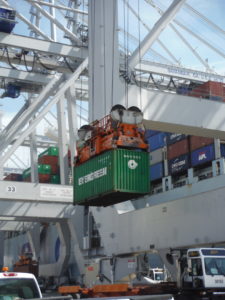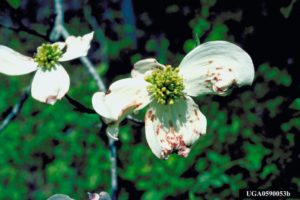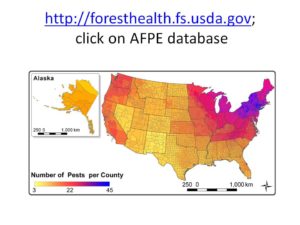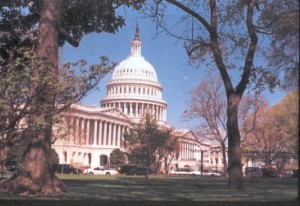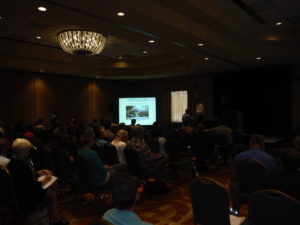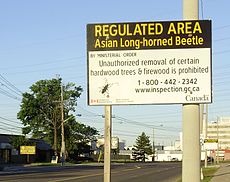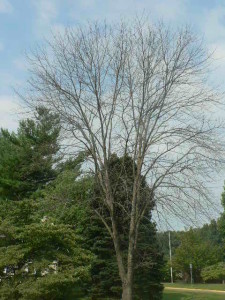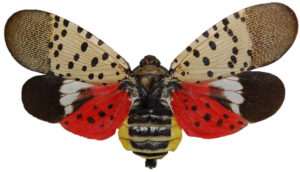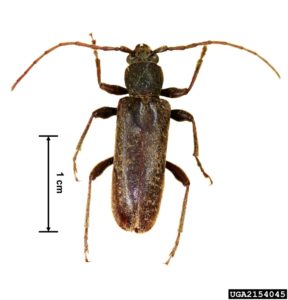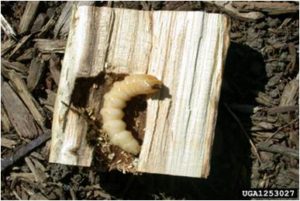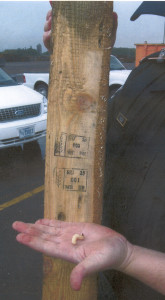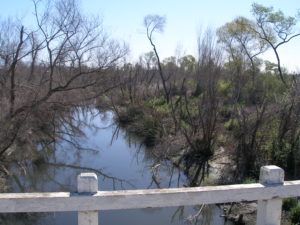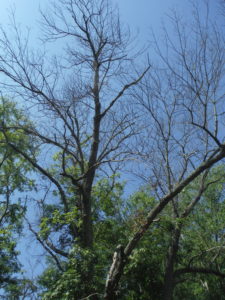Congress is now considering funding for various agencies and programs for Fiscal Year 2018 – which begins on October 1. Please contact your Representative and Senators and urge them to support adequate funding for key programs managed by the USDA Animal and Plant Health Inspection Service (APHIS). These are essential for keeping the nation’s forests healthy by preventing introduction and spread of invasive pests. While I would much prefer to increase funding for these programs, that is impossible at this time. So I suggest that you support maintaining last year’s funding levels for two budget“lines” under the USDA APHIS Plant Health program: $54 million for the “Tree and Wood Pests” line and $156 million for the “Specialty Crops” line.
I have blogged often about the impacts of non-native insects and pathogens inthe United States — which are enormous. (See Lovett et al. 2016 for a summery.) As new pests are introduced and established pests spread, these costs will only continue to rise.
Moreover, since 1975, U.S. imports (excluding petroleum products) have risen almost six times faster than APHIS and Customs and Border Protection’s staff capability to inspect them. As a result of this and other prevention failures, such as insufficiently protective regulations, more than a dozen new plant pests are detected in the United States each year. Since the beginning of the 21st Century, at least 20 wood–boring beetles have been detected here, including:
- Redbay ambrosia beetle / laurel wilt disease;
- Sirex woodwasp;
- Goldspotted oak borer;
- Walnut twig beetle and thousand cankers disease ;
- Soapberry borer;
- Polyphagous & Kuroshio shot hole borers; and
- Velvet longhorned beetle.
Another dozen tree-killing pests that are not wood borers have also been detected, including Spotted lanternfly.
APHIS Programs Target only a Few of the Damaging Pests in the Country
At least in part because of inadequate funding, APHIS currently funds comprehensive programs targeting only four of the dozens of already- or potentially-serious tree-killing pests already in the country: gyspy moth (both European and Asian); Asian longhorned beetle; emerald ash borer; and sudden oak death.
APHIS also provides limited assistance to programs on other pests through grants under the Section 10007 of the 2014 Farm Bill. One example is research to determine host ranges and possible control method for the polyphagous and Kuroshio shot hole borers. However, these funds have not been sufficient to support comprehensive suppression or eradication programs despite the threat posed by these two shot-hole borers. They threaten to kill 26 million trees – more than a third of the trees growing in urban areas in California’s Inland Empire, Coastal Southern California, and Southwest Desert. Absent an active APHIS program to develop effective control measures, the municipalities and homeowners of these regions will be forced to absorb an estimated $36.2 billion (the costs of removing and replacing dead and dying trees) if they want to maintain valuable urban forest canopy.
willow killed by Kuroshio shot hole borer
in Tijuana River estuary, California
photo by John Boland
The shot-hole borers might also threaten trees across the American South. Box elder, sweetgum, and tree of heaven are reproductive hosts for the polyphagous shot hole borer; all are widespread in southern forests. California species of sycamore, oak, and willow are also reproductive hosts; other trees in these genera, which grow widely across the U.S., might also be vulnerable to the shot hole borers.
APHIS also has devoted Section 10007 funds to the spotted lanternfly, which is found in southeastern Pennsylvania. This insect feeds on several crop trees as well as oak, walnut, poplar, and pine trees. Pennsylvania authorities cannot complete eradication of this pest without additional federal funding – which so far is uncertain.
APHIS has helped with trace-forwards to find furniture infested by the velvet longhorned beetle, but has not adopted a program targetting this species in the several states where it appears to be established.
As these examples illustrate, even maintaining current funding levels means that several damaging non-native insects and pathogens continue to spread without a meaningful federal response. Any cuts would only exacerbate the failure of APHIS’ program to protect our forests from non-native insects and pathogens.
Remember, too, that additional introductions are likely in coming years. According to one study, perhaps 35 shipping containers entering the country each day carry damaging pests.
Unloading largest container ship to visit a U.S. East Coast port – “Cosco Development”; Savannah, GA May 12, 2017; F.T. Campbell
At the same time, we cannot afford for APHIS to reduce its ongoing programs in order to address the other invaders. The Asian longhorned beetle eradication program, at a cost of $35 – $40 million per year, has succeeded in eradicating 85% of the infestation in New York. (APHIS has just announced that a section of the borough of Queens is free of ALB.) However, the infestations in Massachusetts and Ohio still threaten to spread further into the forests. The $5 – $6 million per year allocated to the gypsy moth appears to be adequate, but APHIS must be prepared to eradicate any newly detected outbreaks, especially of the Asian gypsy moth on the west coast.
APHIS’ emerald ash borer program has received $7 million per year. To reduce future costs, the agency has cut back its regulatory program, so that it enforces regulations only at the infestation’s leading edge. In affected states, APHIS will continue surveys in unregulated areas, outreach, and coordination. These changes, taken together, undermine efforts to prevent the beetle’s spread to the vulnerable rural and urban forests in North Dakota, Oregon, and other states. APHIS is emphasizing production and dispersal of biocontrol agentsrather than regulatory measures
The sudden oak death program – targeting the pathogen Phytophthora ramorum — is under the “Specialty Crops” funding line. This must also be maintained at current levels because SOD threatens such important eastern forest tree species as northern red, chestnut, white, and pin oaks; sugar maple; and black walnut. APHIS regulates movement of nursery stock which could transport this pathogen from the West coast to vulnerable areas in the East. It was learned recently that APHIS needs to add the genus Magnolia to the “filthy five” group which is subject to the most careful regulation.
Whom to Contact
Please ask your Senators and Representative to support maintaining – or even increasing – funding for these APHIS programs. Your contact is especially important if you are represented by one of the members of the House or Senate Appropriations Committee’s Subcommittees on
Agriculture:
House:
* Robert Aderholt, Alabama, Chairman
* Kevin Yoder, Kansas
* Tom Rooney, Florida
* David Valadao, California
* Andy Harris, Maryland
* David Young, Iowa
* Steven Palazzo, Mississippi
* Sanford Bishop, Georgia, Ranking Member
* Rosa DeLauro, Connecticut
* Chellie Pingree, Maine
* Mark Pocan, Wisconsin
Senate:
John Hoeven, North Dakota
Thad Cochran, Mississippi
Mitch McConnell, Kentucky
Susan Collins, Maine
Roy Blunt, Missouri
Jerry Moran, Kansas,
Marco Rubio, Florida
Jeff Merkley, Oregon
Diane Feinstein, California
Jon Tester, Montana
Tom Udall, New Mexico
Patrick Leahy, Vermont
Tammy Baldwin, Illinois
Sources
Lovett, G.M., M. Weiss, A.M. Liebhold, T.P. Holmes, B. Leung, K.F. Lambert, D.A. Orwig , F.T. Campbell, J. Rosenthal, D.G. McCullough, R. Wildova, M.P. Ayres, C.D. Canham, D.R. Foster, S.L. LaDeau, and T. Weldy. 2016. Nonnative forest insects and pathogens in the United States: Impacts and policy options. Ecological Applications, 0(0), 2016, pp. 1–19. DOI 10.1890/15-1176.1 available at
http://onlinelibrary.wiley.com/doi/10.1890/15-1176/full
Additional recent sources of information on tree-killing pests not being addressed by APHIS:
Article about the damage caused by the goldspotted oak borer:
Videos:
GSOB at Irvine Regional Park in OC
https://www.youtube.com/watch?v=eCRVmP5KmW0&feature=youtu.be
Goldspotted Oak Borer video
https://www.youtube.com/watch?v=In2e5atd3ZY&feature=youtu.be#t=13.3989831
The Los Angeles Times has published two recent articles about the shot hole borers at
http://www.latimes.com/local/california/la-me-dying-urban-trees-20170403-story.html
and
http://www.latimes.com/local/california/la-me-trees-change-20170427-story.html
We welcome comments that supplement or correct factual information, suggest new approaches, or promote thoughtful consideration. We post comments that disagree with us — but not those we judge to be not civil or inflammatory.
Posted by Faith Campbell


